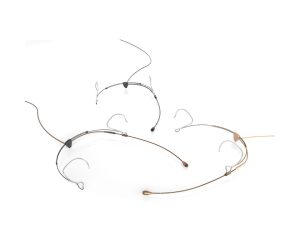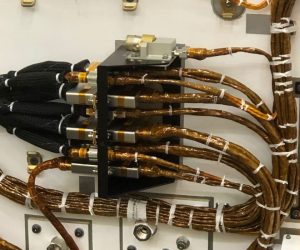
DPA 5100 MOBILE SURROUND MICROPHONE

DPA’s entry into the 5.1 microphone market looks like a luxurious bicycle seat, but just how comfortable is it? Let’s take it for a spin.
Text: Greg Simmons
The 5.1 microphone… It’s an interesting conundrum: how do you make a microphone array that creates
a convincing sense of immersion through a playback system that is fundamentally flawed at creating a convincing sense of immersion?
To create the correct context for this review, we must begin by looking at the 5.1 concept and its strengths and weaknesses. Figure 1 (overleaf) shows the ITU recommendation for setting up a 5.1 playback or monitoring system. Introduced in 1992 and still going strong, the 5.1 system uses six discrete audio channels to feed six discrete speakers. Five of those channels are designated Left Front (Lf), Right Front (Rf), Centre (C), Left Surround (Ls) and Right Surround (Rs), and are all full-range channels (20Hz to 20kHz) intended to drive full-range speakers. The sixth channel (not shown in Figure 1) is the Low Frequency Enhancement (LFE) channel; it’s a distinctly separate channel designed to reproduce low-frequency signals that film sound engineers create to strengthen explosions and similar effects. It has an upper frequency limit of 120Hz, giving it a fraction of the bandwidth of the other channels; hence it’s the ‘0.1’ channel.
With three speakers covering the front 60° (Lf, C and Rf), the 5.1 system is capable of remarkably convincing frontal imaging; but with the remaining 300° covered by just four speakers (Rf, Rs, Ls and Lf), the imaging capabilities for the rest of the sound field are very poor. Furthermore, human hearing has poor localisation for sounds arriving from the extreme sides and the rear, so we instinctively turn our heads towards sounds coming from those directions to localise them properly. It works well in the real world, but turning towards sounds from the extreme sides or rear of
a 5.1 system pulls us out of the highly convincing 60° frontal image and therefore ruins the sound illusion, or, to use movie terminology, “…destroys the willing suspension
of disbelief.” That’s why film mixing engineers obey the golden rule of never putting anything distracting in the surround channels.
From this we can deduce that a successful 5.1 recording takes advantage of the system’s strengths by keeping the listener’s attention focused towards the front, and avoids its weaknesses by using the rear channels for atmos, ambience and/or room sound only, with no distractions. A good 5.1 microphone array should, therefore, offer pinpoint imaging for frontal sounds (to maintain the listener’s attention), and a good sense of spaciousness for rear sounds (to create a sense of immersion that supports the frontal image). DPA’s 5100 ‘Mobile Surround Microphone’ does this seriously well – despite looking like a bicycle seat.
IN THE DRIVING SEAT
The 5100 consists of five individual microphones in a self-contained housing. Each of the three front microphones (Lf, C and Rf) is a pressure capsule (i.e. single-diaphragm omnidirectional) fitted with a specially developed interference tube to create what DPA refers to as a ‘Directional Pressure Microphone’ (‘DiPMic’ for short – a registered trademark). This combines all the benefits that a pressure capsule offers for location recording – including consistent low-frequency response regardless of distance, and less susceptibility to wind and handling noise – with the added benefits of a directional polar response. The DiPMic itself is a very interesting development, but this is not the place for a lecture on microphone capsule design.
The three front microphones are set up as a coincident trio and then mounted in a baffled enclosure, producing solid imaging across the front three channels while maintaining mono compatibility (and thereby making the stereo fold-down a cinch). Furthermore, the polar responses of these three microphones and the subtended angles between them have been designed so that the centre microphone is a fundamental part of the frontal image. Playing the front left and front right microphones only, as a stereo pair, reveals a considerable hole in the middle of the image that is precisely filled in when the centre microphone is added, locking the complete frontal image in place. This alone is quite an achievement in polar response design, but is even more admirable when considering how the polar responses of the front left and front right microphones have been shaped to work in conjunction with their rear counterparts. For example, the forward-facing side of the front left microphone’s polar response is shaped to work in conjunction with the centre microphone, while its rear-facing side is shaped to work in conjunction with the rear left microphone. To pull this trick off requires that each of the 5100’s microphones, except the centre, has a non-symmetrical polar response above 1kHz. Very interesting…
The two rear microphones use pressure capsules but don’t require DiPMic technology, relying only on baffles between each other and the frontal array to provide their directionality. They are sufficiently spaced apart from each other and the frontal array to capture the low-frequency inter-channel phase differences that are vital for creating a sense of immersion. Soloing the rear microphones reveals very little of the front microphone’s direct content, and vice versa, which is important if you want to create a decent sense of immersion through a 5.1 system – any common sound between the front and rear channels collapses the image into the centre of the 5.1 monitoring system (i.e. the listener’s head) and destroys the sense of immersion.
It’s a credit to DPA’s understanding of microphone technology that it has been able to create the unique polar responses required for each channel of the 5100 while maintaining the benefits of pressure capsules throughout.
SUM OF THE PARTS
What about the 0.1 channel? For what it’s worth, the 5100’s LFE signal is created electronically by summing the individual microphone signals and applying a low-pass filter (set to 120Hz and attenuated –10dB in accordance with the LFE level standard).
With the microphones, interference tubes, baffles and LFE electronics, the insides of the 5100 must be quite complicated. DPA has chosen to stitch the entire thing up inside a tough black fabric cover, keeping it safe from prying fingers while also serving as a wind filter. There are no zippers, Velcro strips or press-studs; obviously you’re not supposed to be poking around inside.
For outdoor use the supplied OC5100 cover provides wind and rain protection without causing any apparent loss of high frequencies. Apart from keeping the rain out of the microphones, it does a good job of keeping the sound of the rain hitting it from becoming too obtrusive (especially if it’s slid up a few millimetres so that the top of the OC5100 is not in direct contact with the top of the 5100 itself).
If you need further protection, the optional WJ5100 windjammer offers the traditional furry covering and can be used with or without the OC5100 fitted.
SURROUNDED (BY MOUNTAINS)
I was fortunate to have the 5100 for an extended review period; long enough to take on a six-week recording expedition through Nepal and India. During that time I used it in conjunction with an HHB Portadrive to capture many different situations in 5.1 including jungle and river ambiences, traditional music and atmos in Himalayan villages, bustling city soundscapes and, my old favourite, the harmonic chanting of Tibetan monks.
This journey involved numerous modes of travel through vast differences in altitude, temperature and humidity, all of which would certainly have revealed any performance flaws, reliability issues and/or impracticalities in the 5100’s design, had any existed. As it is, there isn’t much to complain about; it’s light, packs easily, is always ready to go, and the detachable ultra-flexible Mogami cable makes it fast to set up and pack down (assuming you leave the other end of the cable, with all of the individual XLRs, permanently plugged into the recorder). In fact, it’s one of the most easy-going microphones I’ve ever worked with.
DPA has included threaded mounting points on the top and bottom of the 5100, allowing numerous configurations. For a recording made in an old palace by the Ganges in Varanasi we made good use of the top thread by suspending the 5100 from the ceiling – although I doubt that’s what DPA had in mind. A more likely intention would be mounting a pistol grip to the bottom thread and a shotgun or parabolic mic to the top thread, making a good option for capturing sports events in 5.1 with the benefit of a centre ‘zoom’ that could be tweaked in post.
HOW DOES IT SURROUND?
The 5.1 effect created by the 5100 is quite wonderful, within the limitations of the 5.1 system itself and the characteristics of the recorded subject. Given the right subject and microphone placement, the resulting recordings offered solid imaging and a good sense of immersion.
The sound is clean and clear, as expected from DPA, and somewhat more natural than anticipated. Although the specifications suggest that it uses the same or similar 5.4mm diameter capsules as DPA’s 4060 series, the 5100 does not have the subtle brightness inherent in the 4060s; perhaps that’s the effect of the interference tubes, baffles and fabric shell combined with the distances used from the sound source when making a 5.1 recording. Suffice it to say, it is good.
There is a caveat, however. Those tiny 5.4mm diaphragms are a necessity for achieving the off-axis responses required for capturing a convincingly natural sound from 360°, but small diaphragms go hand-in-hand with higher self-noise – that’s an unavoidable law of microphone physics, unfortunately. Quoted as typically 18dB(A) for the front mics and 20dB(A) for the rear mics, it means the 5100 is not something you’d use to record very soft atmos sounds, especially those lacking in sufficient HF energy to mask the capsules’ self-noise. There are no problems, however, recording cityscapes, traffic sounds, market places, swamps full of amphibians and insects, and so on. On the positive side, with high sensitivities of 26mV/Pa for the front mics and 28mV/Pa for the rear mics, you won’t be adding any noise from your microphone preamplifiers.
My only gripe, and it is minor, is with the multi-pin connector. I’d like to see a slightly larger version, which in turn had larger pins and sockets. The one supplied –
a high quality 18-pole Lemo 2B series – has such small pins and sockets that if a bit of dust or dirt got in there it could cause problems; it didn’t happen during my six week journey, but it’s a possibility I’d rather not
contend with.
THE HOT SEAT
The 5100 is an intelligently conceived and simple-to-use implementation of the direct-to-5.1 microphone, putting accurate localisation in the front where you need it, and a sense of spaciousness in the rear where it belongs. In
the hands of an engineer with a good understanding of the limitations of the 5.1 system itself, the 5100 is capable of making very impressive recordings that do not rely on supporting visuals to sell the illusion.
The recommended retail price of $5499 is acceptable considering that the 5100 offers five very innovative microphone systems, each customised for their specific application, bundled into a specially shaped and baffled enclosure that’s always ready to go. That’s quite a package, in my opinion. Would I buy one? It’s on the shopping list…
















RESPONSES